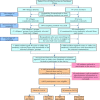Sex-based differences in and risk factors for metabolic syndrome in adults aged 40 years and above in Northeast China: Results from the cross-sectional China national stroke screening survey
- PMID: 33762227
- PMCID: PMC7993204
- DOI: 10.1136/bmjopen-2020-038671
Sex-based differences in and risk factors for metabolic syndrome in adults aged 40 years and above in Northeast China: Results from the cross-sectional China national stroke screening survey
Abstract
Objectives: Low levels of income and education are risk factors for metabolic syndrome in the population of Northeast China, which has a high incidence of metabolic syndrome and cardiovascular diseases. This study aimed to determine sex-based differences associated with the prevalence of and risk factors for metabolic syndrome among people older than 40 years in Northeast China; this has not been previously investigated.
Design: This study analysed a portion of the large sample data of the national cross-sectional screening of China from 2016. Metabolic syndrome was defined as the presence of any three of the following five risk factors: abnormal waist circumference; high levels of triglycerides, high-density lipoprotein cholesterol or fasting plasma glucose; and elevated blood pressure. Multiple regression analysis was used to investigate sex-based differences in the prevalence of, and risk factors for metabolic syndrome.
Setting: The study was conducted in Dehui City, Jilin Province, China.
Participants: A total of 4052 participants with complete questionnaire information and laboratory examination results were included.
Results: The prevalence of metabolic syndrome was 50.1% overall (38.4% in men and 57.9% in women; p<0.001). High body mass index and hip circumference were associated with metabolic syndrome in both sexes. In addition, physical inactivity (OR and 95% CI 1.44 (1.06 to 1.97); p=0.022) in men and advanced age (OR and 95% CI 1.54 (1.15 to 2.04); p=0.003) in women were factors associated with metabolic syndrome. Women with junior high school education or above and living in rural areas were less likely to have metabolic syndrome. For men, education and rural or urban living had no association with metabolic syndrome.
Conclusions: The risk factors for metabolic syndrome have similarities and differences in different sexes; thus, the prevention and treatment of metabolic syndrome should be based on these sex differences.
Keywords: e.g. iron; hypertension; lipid disorders; other metabolic; porphyria; preventive medicine; risk management; sex steroids & hrt.
© Author(s) (or their employer(s)) 2021. Re-use permitted under CC BY-NC. No commercial re-use. See rights and permissions. Published by BMJ.
Conflict of interest statement
Competing interests: None declared.
Figures
Similar articles
-
An urban-rural comparison of the prevalence of the metabolic syndrome in Eastern China.Public Health Nutr. 2007 Feb;10(2):131-6. doi: 10.1017/S1368980007226023. Public Health Nutr. 2007. PMID: 17261221
-
Prevalence of stroke and associated risk factors: a population based cross sectional study from northeast China.BMJ Open. 2017 Sep 3;7(9):e015758. doi: 10.1136/bmjopen-2016-015758. BMJ Open. 2017. PMID: 28871014 Free PMC article.
-
Prevalence of metabolic syndrome and its risk factors among 10,348 police officers in a large city of China: A cross-sectional study.Medicine (Baltimore). 2019 Oct;98(40):e17306. doi: 10.1097/MD.0000000000017306. Medicine (Baltimore). 2019. PMID: 31577722 Free PMC article.
-
Association between elevated serum alanine aminotransferase and cardiometabolic risk factors in rural Chinese population: a cross-sectional study.BMC Cardiovasc Disord. 2015 Jul 10;15:65. doi: 10.1186/s12872-015-0060-y. BMC Cardiovasc Disord. 2015. PMID: 26160405 Free PMC article.
-
Prevalence of metabolic syndrome among adult population in India: A systematic review and meta-analysis.PLoS One. 2020 Oct 19;15(10):e0240971. doi: 10.1371/journal.pone.0240971. eCollection 2020. PLoS One. 2020. PMID: 33075086 Free PMC article.
Cited by
-
The Metabolic Syndrome, a Human Disease.Int J Mol Sci. 2024 Feb 13;25(4):2251. doi: 10.3390/ijms25042251. Int J Mol Sci. 2024. PMID: 38396928 Free PMC article. Review.
-
Assessing metabolic syndrome prediction quality using seven anthropometric indices among Jordanian adults: a cross-sectional study.Sci Rep. 2022 Dec 6;12(1):21043. doi: 10.1038/s41598-022-25005-8. Sci Rep. 2022. PMID: 36473903 Free PMC article.
-
Oxidative balance score inversely associated with the prevalence and incidence of metabolic syndrome: analysis of two studies of the Korean population.Front Nutr. 2023 Aug 16;10:1226107. doi: 10.3389/fnut.2023.1226107. eCollection 2023. Front Nutr. 2023. PMID: 37654473 Free PMC article.
-
Accuracy of the Modified Finnish Diabetes Risk Score (Modified FINDRISC) for detecting metabolic syndrome: Findings from the Indonesian national health survey.PLoS One. 2025 Feb 12;20(2):e0314824. doi: 10.1371/journal.pone.0314824. eCollection 2025. PLoS One. 2025. PMID: 39937716 Free PMC article.
-
The Added Value of Combined Timed Up and Go Test, Walking Speed, and Grip Strength on Predicting Recurrent Falls in Chinese Community-dwelling Elderly.Clin Interv Aging. 2021 Oct 5;16:1801-1812. doi: 10.2147/CIA.S325930. eCollection 2021. Clin Interv Aging. 2021. PMID: 34675495 Free PMC article.
References
Publication types
MeSH terms
LinkOut - more resources
Full Text Sources
Other Literature Sources
Medical


